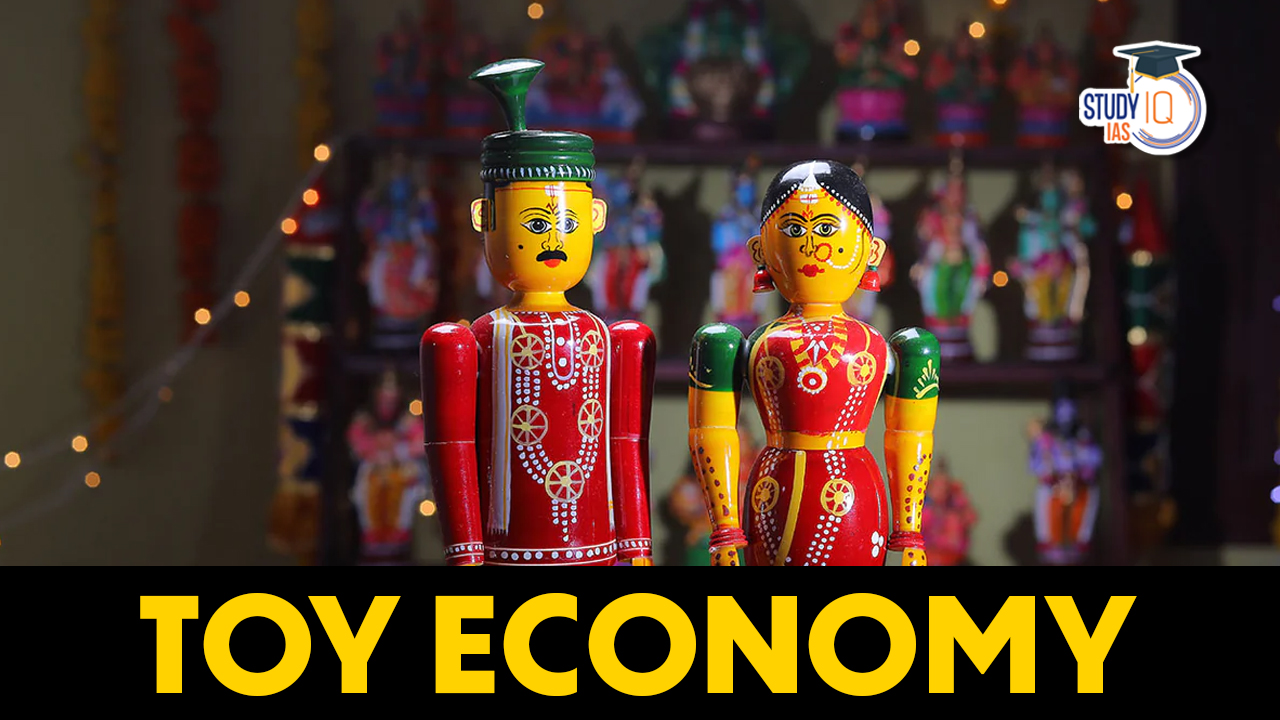Table of Contents
Context: India turning a net exporter of toys is mainly due to rising protectionism and less on account of expanding domestic capabilities.
Toy Economy Background
- India has recently turned a net exporter of toys, during 2020-21 and 2021-22, ending decades of import dominance.
- The toy exports of India increased from $109 million (Rs 812 crore) to $177 million (Rs 1,237 crore) between 2018-19 and 2021-22.
- Beyond an increase in exports, the imports of toys, which used to be over Rs 3,000 crores, has fallen by 70%, signifying a drop in India’s reliance on foreign-made toys — especially from China.
- Amid the COVID-19 pandemic in 2020, India showed remarkable progress with the prospect of becoming a global toy hub.
Toy Manufacturing in India
- It dates back to the Indus valley civilization; five thousand years ago, when toys were introduced.
- Earlier toys include whistles shaped like birds, Monkey toys, and small & large carts mostly made from natural sticks, clay, and rocks.
- Due to advances in technology, currently, modern machines are used to produce modern & innovative toys.
Indian’s Toy Market
- Economic value: In 2015-16, the industry had 15,000 establishments, producing toys valued at Rs 1,688 crore and employed 35,000 workers.
- Registered factories employing 10 or more workers on a regular basis accounted for 1% of the number of factories and enterprises.
- Decline: During 2000 and 2016, industry output was halved in real terms with job losses.
- Imports: Between 2000 and 2018-19, imports rose by nearly three times as much as export. Imports accounted for up to 80% of domestic sales until recently. India imports 80% of its toys predominantly from China which means that India is being able to full fill only 20% of the domestic demand.
- Growth: Between 2014 and 2019, the Indian toy industry witnessed negative productivity growth. The Indian Toy Market attained a value of US $1.23 Billion in 2020.
- The Indian toys market is expected to grow at a CAGR of 12.2% during 2021-2026.
- Decline in imports: However, in 2022, India’s exports of toys surged considerably and also its imports fell by 70%.
- One of the major reasons behind the decline was the increase of Basic Customs Duty on the import of toys from 20% to 60%.
- Non-tariff barriers were imposed as well such as production registration orders and safety regulation codes, which contributed to import decline.
How Protectionism is Boosting India’s Toy Industry?
- Government initiatives like Make in India have a negligible effect in strengthening toy production and exports on a sustained basis.
- This is because the annual value of output and fixed investment at constant prices after peaking in 2007-08, have trended downwards with considerable fluctuations.
- The potential for sustaining net exports appears low as the industry has made no significant sustained investment to boost output and exports.
- India’s export surplus in toys during 2020-21 and 2021-22 was due to rise in protectionism and COVID-19 pandemic-related global disruptions.
| Exports: | Imports: |
|
|
Importance of India’s Toy Industry
- Economic opportunities:
- Huge consumer base: The country has a very large young population with around half of the total population under the age of 25, creating a large platter of potential consumers.
- Some reports suggest that India’s toy market has the potential to double to $2 billion by 2025.
- Growing demand with the rise of the middle class: Growing demand and decreasing cost of production have resulted in a major shift from traditional, medium- to low-end battery-operated toys, towards innovative electronic toys, and intelligent toys.
- High employment generating sector: Large MSME presence in the sector has the potential to generate large employment through artisans, small traders and MSME manufacturers.
- Emergence of digital marketplace: The growth of E-commerce has helped overcome logistical difficulties and has expanded the reach of local and traditional toy markets.
- Growth of E-commerce has indirectly increased the export potential of local manufacturers who can now compete in the global markets.
- Huge consumer base: The country has a very large young population with around half of the total population under the age of 25, creating a large platter of potential consumers.
- Societal opportunities:
- Growing educational toys market: Toys have an impact on the overall development of a child. E.g.: motor, psychomotor, and cognitive skills and also stimulate creativity.
- Shaping the value system: Toys bring to life society’s traditions, beliefs, values, and ethos and thus can act as an agent of propagation of ethics and progressive value systems.
- Increasing cultural awareness: Toys can be used to increase curiosity in histories, mythology etc. by recreating cultural characters.
Challenges in Indian Toy Market
- Availability of Foreign Toys in the Indian Market: After the liberalized economy, an inflow of cheap toys from other countries surpassed the traditional toy market in India. This results in the closure of many toy factories in India and not competing with Chinese products, primarily in electric and electronic-based toys.
- Limitations of manufacturing facilities: Poor infrastructure and the absence of end-to-end manufacturing facilities hinder the sector’s growth.
- Economies of scale issue: Toy manufacturing economies significantly depend on large production for profitability and thus require high investment and continuous demand, which is unavailable in emerging markets like India.
- Impact of Increased Import Duties There is an increase in import duty for some raw materials, which makes Indian Toys to be more expensive.
- Absence of skilled labour: Toy manufacturing requires specific skill sets which are unavailable in India’s predominantly unskilled labour.
- Fragmented market: India’s toy market is largely fragmented with limited linkages between local artisans, manufacturers and marketing agents such as local traders.
- No Uniform Demand Toy making is labour intensive. The life of a toy is for a limited period only. Some toys are also seasonal and depend on the vacation time of the kids.
- Technological challenges: With the evolution of the gaming industry, demand for the manufacturing of digitally high-end toys is growing. But this requires technological skill sets which are either unavailable or unaffordable to the local industry.
Initiatives by the Government
- Indigenous toy clusters: Several Toy clusters have been approved under the Scheme of Fund for Regeneration of Traditional Industries (SFURTI) such as the Lucknow Soft toys cluster and the Wood craft cluster of Jodhpur.
- National Toy Action Plan: The Government of India, by involving 15 ministries has prepared a National Toy Action Plan to make the Indian toy industry competitive. It is a big Make in India push for domestic manufacturing of toys.
- Product Specific Industrial Cluster Development Programme: It aims to build toy clusters in dedicated SEZs to help them become self-sustained ecosystems catering to export markets.
- Other initiatives taken by the Government:
- First-of-its-kind Virtual India Toy Fair 2021 was organized.
- “Toys” is identified as one of the key sectors under Aatmanirbhar Bharat Abhiyan.
- Toycathon-2021 was launched to challenge India’s innovative minds to conceptualize novel toys and games based on Indian civilization, history, culture, mythology, and ethos.
Way Forward
- Enhancing manufacturing competitiveness by addressing the raw material issues, streamlining the GST input credit structure and overcoming the supply chain issues.
- Skilling & R&D to bridge the persistent gap in demand and supply. Incentivizing technical institutes to offer specialized courses in toy and game design and incentivizing knowledge mobility across institutions.
- Improving Ease of doing business through a one-stop shop like “National Creative Hub (C-Hub)”, improving digital preparedness and leveraging the growing start-up ecosystem.
- Strategic relationships with global players to leverage Science, Technology, Engineering, Art and Math toys.
- Leveraging National Education Policy 2020 to push local artisans and promoting initiatives like toy-based tourism, Local “Toy Banks” and “Toy Library” models.
- Developing a standard norm and increasing the number of labs in testing and certification and expanding geographic coverage of these labs.


 Civil Services Day 2025, Date, History, ...
Civil Services Day 2025, Date, History, ...
 GPSC Syllabus, Download Prelims and Main...
GPSC Syllabus, Download Prelims and Main...
 MPSC Syllabus 2025, Exam Pattern, Downlo...
MPSC Syllabus 2025, Exam Pattern, Downlo...





















